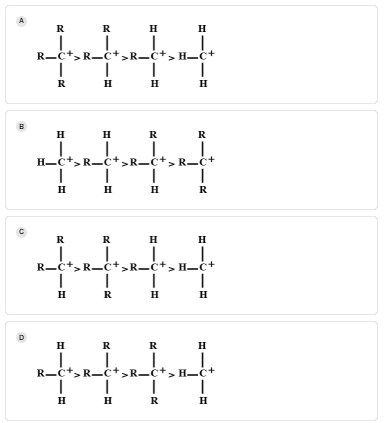
The decreasing order of stability of alkyl carbocation is:

Answer
133.5k+ views
Hint: As we know that carbocation is a group of atoms in which a carbon atom is positively charged. Carbocation is an electron deficient species.
Complete answer:
As tertiary carbocation contains three alkyl groups, so they have three methyl groups to distribute its positive charge than primary and secondary carbocation because they both contain one and two alkyl groups respectively. Three H-atoms are attached in the methyl group but adjacent hydrogen does not stabilize carbocation. So, the decreasing order of stability of carbocation is as follows:
Tertiary > secondary > primary > methyl

Hence, the correct answer is A.
Additional Information:
In carbocation, the hybridization of carbon is and its shape is trigonal planar. The empty p orbital indicates that it has an electron-deficient nature. The carbon has 6 electrons in its valence shell. Carbocation is formed by two ways they are cleavage of bonds of carbon and electrophilic addition. The cleavage of the carbon bond and the atoms attached to it takes away the shared electrons from the leaving group. And it makes the carbon atom deficient as an electron. As a result, a positive charge is formed which is known as carbocation. An electrophile attacks on an unsaturated point (that is double or triple bond) in electrophilic addition, this results in the cleavage of the pi bond which results in the formation of a carbocation.
Note:
Students might confuse among primary, secondary and tertiary alkyl groups. Primary carbon is bonded to one other carbon while tertiary and secondary are bonded to three and two carbon respectively.

Complete answer:
As tertiary carbocation contains three alkyl groups, so they have three methyl groups to distribute its positive charge than primary and secondary carbocation because they both contain one and two alkyl groups respectively. Three H-atoms are attached in the methyl group but adjacent hydrogen does not stabilize carbocation. So, the decreasing order of stability of carbocation is as follows:
Tertiary > secondary > primary > methyl

Hence, the correct answer is A.
Additional Information:
In carbocation, the hybridization of carbon is and its shape is trigonal planar. The empty p orbital indicates that it has an electron-deficient nature. The carbon has 6 electrons in its valence shell. Carbocation is formed by two ways they are cleavage of bonds of carbon and electrophilic addition. The cleavage of the carbon bond and the atoms attached to it takes away the shared electrons from the leaving group. And it makes the carbon atom deficient as an electron. As a result, a positive charge is formed which is known as carbocation. An electrophile attacks on an unsaturated point (that is double or triple bond) in electrophilic addition, this results in the cleavage of the pi bond which results in the formation of a carbocation.
Note:
Students might confuse among primary, secondary and tertiary alkyl groups. Primary carbon is bonded to one other carbon while tertiary and secondary are bonded to three and two carbon respectively.

Recently Updated Pages
Sign up for JEE Main 2025 Live Classes - Vedantu

JEE Main Books 2023-24: Best JEE Main Books for Physics, Chemistry and Maths

JEE Main 2023 April 13 Shift 1 Question Paper with Answer Key

JEE Main 2023 April 11 Shift 2 Question Paper with Answer Key

JEE Main 2023 April 10 Shift 2 Question Paper with Answer Key

JEE Main 2023 (April 6th Shift 2) Chemistry Question Paper with Answer Key

Trending doubts
JEE Main 2025 Session 2: Application Form (Out), Exam Dates (Released), Eligibility & More

JEE Main 2025: Conversion of Galvanometer Into Ammeter And Voltmeter in Physics

JEE Main 2025: Derivation of Equation of Trajectory in Physics

Electric Field Due to Uniformly Charged Ring for JEE Main 2025 - Formula and Derivation

Current Loop as Magnetic Dipole and Its Derivation for JEE

Inertial and Non-Inertial Frame of Reference - JEE Important Topic

Other Pages
NCERT Solutions for Class 11 Chemistry Chapter 9 Hydrocarbons

JEE Advanced Marks vs Ranks 2025: Understanding Category-wise Qualifying Marks and Previous Year Cut-offs

NCERT Solutions for Class 11 Chemistry Chapter 5 Thermodynamics

Hydrocarbons Class 11 Notes: CBSE Chemistry Chapter 9

NCERT Solutions for Class 11 Chemistry Chapter 7 Redox Reaction

Thermodynamics Class 11 Notes: CBSE Chapter 5




